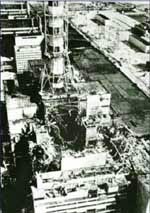



Context - Some 30 years ago, the most serious accident in nuclear history changed the lives of many. Massive amounts of radioactive materials were released into the environment resulting in a radioactive cloud that spread over much of Europe.
The greatest contamination occurred around the reactor in areas that are now part of Belarus, Russia, and Ukraine.
How has this region been affected by the accident and how has it coped?
This report remains a reference even if in 2016 WHO published an ![]()
This Digest is a faithful summary of the leading scientific consensus report produced in 2006 by the UN Chernobyl Forum: "![]()
The Chernobyl nuclear power plant is located in Ukraine, 20km south of the border with Belarus. At the time of the accident, the plant had four working reactors.
The accident occurred on 26 April 1986 when operators of the power plant ran a test on an electric control system of one of the reactors. The accident happened because of a combination of basic engineering deficiencies in the reactor and faulty actions of the operators: the safety systems had been switched off, and the reactor was being operated under improper, unstable conditions, a situation which allowed an uncontrollable power surge to occur.
This led to a cascade of events resulting in a series of explosions and consequent fires that severely damaged the reactor building, completely destroyed the reactor, and caused the release of massive amounts of radioactive materials over a ten-day period. More...

The Chernobyl accident is the most serious accident in the history of the nuclear industry. Indeed, the explosion that occurred on 26 April 1986 in one of the reactors of the nuclear power plant, and the consequent fires that lasted for 10 days, led to huge amounts of radioactive materials being released into the environment and a radioactive cloud spreading over much of Europe. The greatest contamination occurred around the reactor in areas that are now part of Belarus, Russia, and Ukraine.
Since the accident, some 600 000 people have been involved in emergency, containment, cleaning, and recovery operations, although only few of them have been exposed to dangerous levels of radiation. Those who received the highest doses of radiation were the emergency workers and personnel that were on-site during the first days of the accident (approximately 1000 people).
At present, more than five million people live in areas that are considered to be ‘contaminated’ with radioactive materials from the Chernobyl accident 1. The area closest to the reactor site was most heavily contaminated and the 116 000 people who lived there were evacuated soon after the accident. More...
After the accident, people were exposed to radiation both directly from the radioactive cloud and the radioactive materials deposited on the ground, and through consuming contaminated food or breathing contaminated air. More...
2.1 Doses of radiation received during and immediately after the accident were high for some emergency workers, but much lower for later recovery-operation workers and people living in the contaminated areas. Because of contaminated milk, the thyroids of many children were heavily exposed to radioactive iodine.
At present, 100 000 people living in contaminated areas still receive a higher dose of radiation than the limit recommended for the general public. More...
2.2 It is difficult to tell precisely the number of deaths – past and future – attributable to the Chernobyl accident, because people who have been exposed to low levels of radiation often die from the same causes as unexposed people.
Confusion about the impact of the accident has given rise to highly exaggerated claims that tens or even hundreds of thousands of people have died as a result of the accident. In fact, a much smaller death toll can be directly attributable to Chernobyl radiation. Twenty-eight emergency workers died from acute radiation syndrome, 15 patients died from thyroid cancer, and it is roughly estimated that the total number of deaths from cancers caused by Chernobyl may reach 4000 among the 600 000 people having received the greastest exposures. More...
2.3 In the general population of the contaminated regions, there is so far no convincing evidence that Chernobyl has increased the number of cases of leukaemia or solid cancers, except for childhood thyroid cancer.
Thousands of those who were children and adolescents at the time of the accident have developed thyroid cancer as a result of exposure to radioactive iodine. The majority of those cancers have been treated successfully. Among workers who were exposed to higher doses of radiation this exposure has contributed to an increase in the number of cases of certain types of leukaemia and solid cancers, and possibly of cardiovascular diseases and cataracts. Future analytical studies should be able to clarify this. More...
2.4 As most people received relatively low doses of radiation from the Chernobyl accident, there is no convincing evidence of effects on human fertility and heritable diseases, nor have any effects been observed for pregnancy outcomes and on the overall health of children of exposed parents. More...
2.5 Many people were traumatized by the accident and the rapid relocation that followed. Lacking reliable information, they were fearful and anxious about their current and future health and often perceived themselves as weak and helpless victims rather than as survivors. More...
Some areas of Europe were substantially contaminated, particularly in current Belarus, Russia, and Ukraine by the large quantities of radioactive materials released from the damaged reactor. Most of these materials have since transformed into stable, non-radioactive materials but some will remain radioactive for a long time. More...
3.1 The urban areas near the reactor were heavily contaminated and rapidly evacuated. Since the accident, surface contamination has decreased and levels of radiation measured in the air are now the same as before the accident in most of these areas. More...
3.2 Regarding agriculture, the contamination of crops, meat, and milk with short-lived radioactive iodine was a major concern in the early months after the accident. Now and for decades to come, contamination with longer-lived radioactive caesium is the main concern in some rural areas. More...
3.3 Forest food products such as berries, mushrooms, and game contain particularly high levels of long-lived radioactive caesium and this contamination is expected to remain high for several decades. For instance, the accident led to high contamination of reindeer meat in Scandinavia. More...
3.4 As a result of the accident, water bodies and fish became contaminated with radioactive materials. The contamination soon decreased as a result of dilution and decay but some of the materials remained trapped in the soils around contaminated rivers and lakes. Today, most water bodies and fish have low radioactivity levels, although the levels in some closed lakes remain high. More...
3.5 The accident immediately affected many plants and animals living within 30 km of the site. There was an increase in mortality and a decrease in reproduction and some genetic anomalies in plants and animals are still reported today. Over the years, as the radioactivity levels decreased, the biological populations started to recover and the area has become a unique sanctuary for biodiversity. More...
4.1 The authorities of the Soviet Union and, later, of the Commonwealth of Independent States (CIS) spent huge resources to deal with the consequences of the accident. Efforts were made to clean up contaminated areas and to reduce the amount of radioactivity in food and drink with varying degrees of success.
Measures included feeding animals with clean fodder, rejecting contaminated milk, switching to uncontaminated drinking water supplies, and restricting the harvesting of forest food products in contaminated areas. More...

4.2 In the year of the accident, a shelter was built to contain the damaged reactor. The shelter has some imperfections because it was built quickly and under very difficult conditions, as the construction personnel was being exposed to severe radiation levels.
Its general state has deteriorated over the last 20 years, which could potentially lead to the collapse of the Shelter and thus to the release of radioactive dust into the environment. To avoid this, a New Safe Confinement will be built over the original shelter and the damaged reactor will be dismantled. The radioactive waste that will be generated by this construction work will need to be disposed of properly. More...
4.3 There are plans to make use of the areas immediately surrounding the reactor. The zone is unsuitable for residential or agricultural purposes, but it could be used for activities such as the processing of radioactive waste or the development of natural reserves. More...
5.1 The Chernobyl accident and the measures taken to deal with its consequences have cost the Soviet Union – and later Belarus, the Russian Federation and Ukraine – hundreds of billions of dollars. Today, social benefits are paid to about 7 million people who are considered to have been affected in some way by the Chernobyl accident. This spending is a huge burden on national budgets and is unsustainable. More...

5.2 The agricultural sector was the area of the economy worst hit by the effects of the accident. Moreover it has been badly affected by the great economic turmoil of the 1990s. To improve the region’s economy, it is necessary to deal not only with contamination but also with the general socio-economic problems that affect many agricultural areas. More...
5.3 After the accident, more than 330 000 people were resettled outside the most severely contaminated areas. This relocation reduced their exposure to radiation but was a deeply traumatic experience for many.
Communities who remained in their villages have coped better psychologically, but have also been affected by the departure of many young and skilled people. At present, the most pressing health concern in the area is not radiation but poor diets, unhealthy lifestyles, poverty, and limited access to primary health care. More...
5.4 After the accident, the Soviet government set up a massive programme of investment and compensation payments. Over time, the number of people claiming Chernobyl-related benefits soared. Because the present benefit system is unsustainable, it is necessary to concentrate resources on those whose health has actually suffered from the catastrophe and the truly needy. More...
6.1 People living in affected areas are still uncertain about the impact of radiation on their health and surroundings. They mistrust the information provided by governments and different organizations and there are still many misconceptions and myths about the threat of radiation.
Residents are anxious about their health and that of their children, but they are also worried about low incomes and high unemployment. In addition to policies aimed at improving the region’s economy, the residents need clear information they can trust about the accident and radiation. More...
6.2 The current extent of benefit payments is unsustainable and ineffective. It is therefore necessary to divert payments from those who are only mildly affected by the accident, towards those truly in need.

This summary is free and ad-free, as is all of our content. You can help us remain free and independant as well as to develop new ways to communicate science by becoming a Patron!